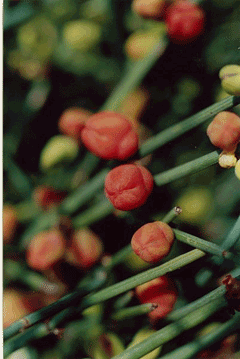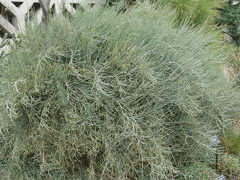 |
|
http://flickr.com/photos/33590535%40N06 |
 |
|
Translate this page:
Summary
Physical Characteristics

 Ephedra equisetina is an evergreen Shrub growing to 1.5 m (5ft) by 1 m (3ft 3in). It is in leaf all year. The species is dioecious (individual flowers are either male or female, but only one sex is to be found on any one plant so both male and female plants must be grown if seed is required). . The plant is not self-fertile.
Ephedra equisetina is an evergreen Shrub growing to 1.5 m (5ft) by 1 m (3ft 3in). It is in leaf all year. The species is dioecious (individual flowers are either male or female, but only one sex is to be found on any one plant so both male and female plants must be grown if seed is required). . The plant is not self-fertile.
Suitable for: light (sandy) and medium (loamy) soils and prefers well-drained soil. Suitable pH: mildly acid, neutral and basic (mildly alkaline) soils. It cannot grow in the shade. It prefers dry or moist soil and can tolerate drought.
UK Hardiness Map
US Hardiness Map
Synonyms
Plant Habitats
Cultivated Beds;
Edible Uses
Edible Parts: Fruit
Edible Uses:
Fruit - raw.
References More on Edible Uses
Medicinal Uses
Plants For A Future can not take any responsibility for any adverse effects from the use of plants. Always seek advice from a professional before using a plant medicinally.
Antidote Antihydrotic Cardiac Diaphoretic Diuretic Pectoral Vasoconstrictor Vasodilator
Members of this genus contain various medicinally active alkaloids (but notably ephedrine) and they are widely used in preparations for the treatment of asthma and catarrh[238]. The whole plant can be used at much lower concentrations than the isolated constituents - unlike using the isolated ephedrine, using the whole plant rarely gives rise to side-effects[254]. Ephedrine has an adrenaline-like action in the body[176]. The plant also has antiviral effects, particularly against influenza[238]. The stems are a pungent, bitter, warm herb that dilates the bronchial vessels whilst stimulating the heart and central nervous system[238]. They are also diaphoretic, diuretic, febrifuge, hypertensive, nervine, pectoral, tonic, vasoconstrictor and vasodilator[165, 176, 238]. They are used internally in the treatment of asthma, hay fever and allergic complaints[238]. They are also combined with a number of other herbs and used in treating a wide range of complaints[238]. This herb should be used with great caution, preferably under the supervision of a qualified practitioner[238]. It should not be prescribed to patients who are taking monoamine oxidase inhibitors, or suffering from high blood pressure, hyperthyroidism or glaucoma[238]. Ephedrine is seen as a performance-boosting herb and, as such, is a forbidden substance in many sporting events such as athletics[K]. The stems can be harvested at any time of the year and are dried for later use[238]. The root is antihydrotic, it lowers blood pressure and dilates the peripheral blood vessels[176]. It is used in the treatment of night sweating and spontaneous sweating[176].
References More on Medicinal Uses
The Bookshop: Edible Plant Books
Our Latest books on Perennial Plants For Food Forests and Permaculture Gardens in paperback or digital formats.

Edible Tropical Plants
Food Forest Plants for Hotter Conditions: 250+ Plants For Tropical Food Forests & Permaculture Gardens.
More

Edible Temperate Plants
Plants for Your Food Forest: 500 Plants for Temperate Food Forests & Permaculture Gardens.
More

More Books
PFAF have eight books available in paperback and digital formats. Browse the shop for more information.
Shop Now
Other Uses
References More on Other Uses
Cultivation details
We have very little information on this species and do not know if it will be hardy in Britain, though judging by its native range it should succeed outdoors in many parts of this country. The following notes are based on the general needs of the genus. Requires a well-drained loamy soil and a sunny position[11]. Established plants are drought resistant and are also lime tolerant[200]. Dioecious, male and female plants must be grown in fruit and seed are required.
References Carbon Farming Information and Carbon Sequestration Information
Temperature Converter
Type a value in the Celsius field to convert the value to Fahrenheit:
Fahrenheit:
The PFAF Bookshop
Plants For A Future have a number of books available in paperback and digital form. Book titles include Edible Plants, Edible Perennials, Edible Trees,Edible Shrubs, Woodland Gardening, and Temperate Food Forest Plants. Our new book is Food Forest Plants For Hotter Conditions (Tropical and Sub-Tropical).
Shop Now
Plant Propagation
Seed - best sown as soon as it is ripe in the autumn in a greenhouse[200]. It can also be sown in spring in a greenhouse in a sandy compost[K]. Prick out the seedlings into individual pots as soon as they are large enough to handle and grow them on for at least their first winter in a greenhouse. Plant out in the spring or early summer after the last expected frosts and give some protection in their first winter[K]. Division in spring or autumn[238]. Layering.
Other Names
If available other names are mentioned here
Native Range
TEMPERATE ASIA: Afghanistan, Georgia, Russian Federation (Dagestan), Russian Federation-Western Siberia (Western Siberia), Kazakhstan, Kyrgyzstan, Tajikistan, Turkmenistan, Uzbekistan, Mongolia, China (Gansu Sheng, Hebei Sheng, Nei Mongol Zizhiqu, Ningxia Huizi Zizhiqu, Qinghai Sheng, Shaanxi Sheng, Shanxi Sheng, Xizang Zizhiqu)
Weed Potential
Right plant wrong place. We are currently updating this section.
Please note that a plant may be invasive in one area but may not in your area so it's worth checking.
Conservation Status
IUCN Red List of Threatened Plants Status :

| Related Plants
|
| Latin Name | Common Name | Habit | Height | Hardiness | Growth | Soil | Shade | Moisture | Edible | Medicinal | Other |
| Ephedra altissima | High-climbing jointfir | Shrub | 0.0 |
0-0
| | LM | N | DM | 1 | 3 | |
| Ephedra americana andina | | Shrub | 1.8 |
5-9
| | LM | N | DM | 2 | 3 | 3 |
| Ephedra ciliata | | Shrub | 0.2 |
-
| | LM | N | DM | 1 | 3 | |
| Ephedra distachya | Sea Grape, Jointfir | Shrub | 1.0 |
5-9
| | LM | N | DM | 2 | 4 | 3 |
| Ephedra fragilis | | Shrub | 1.8 |
7-10
| | LM | N | DM | 2 | 4 | |
| Ephedra gerardiana | Ma Huang, Gerard jointfir | Shrub | 0.6 |
6-9
| | LM | N | DM | 2 | 4 | 3 |
| Ephedra intermedia | Zhong Ma Huang | Shrub | 1.0 |
5-9
| | LM | N | DM | 1 | 4 | |
| Ephedra major | Ma Huang | Shrub | 2.0 |
5-9
| | LM | N | DM | 1 | 4 | |
| Ephedra nevadensis | Mormon Tea, Nevada jointfir | Shrub | 1.2 |
5-9
| | LM | N | DM | 3 | 3 | 0 |
| Ephedra pachyclada | | Shrub | 0.0 |
-
| | LM | N | DM | 2 | 3 | |
| Ephedra sinica | Ma Huang, Chinese ephedra | Shrub | 0.4 |
0-0
| | LM | N | DM | 1 | 4 | |
| Ephedra torreyana | Mexican Tea, Torrey's jointfir | Shrub | 1.0 |
0-0
| | LM | N | DM | 2 | 3 | |
| Ephedra triandra | | Shrub | 0.0 |
-
| | LM | N | DM | 1 | 3 | |
| Ephedra trifurca | Longleaf Jointfir | Shrub | 2.0 |
-
| | LM | N | DM | 1 | 2 | |
| Ephedra viridis | Mormon Tea, Brigham Tea, Long Leaf Ephedra, Mountain Joint Fir, Mormon Tea, Ephedra | Shrub | 1.8 |
6-11
| | LM | N | DM | 2 | 3 | 1 |
|
Growth: S = slow M = medium F = fast. Soil: L = light (sandy) M = medium H = heavy (clay). pH: A = acid N = neutral B = basic (alkaline). Shade: F = full shade S = semi-shade N = no shade. Moisture: D = dry M = Moist We = wet Wa = water.
Now available:
Food Forest Plants for Mediterranean Conditions
350+ Perennial Plants For Mediterranean and Drier Food Forests and Permaculture Gardens.
[Paperback and eBook]
This is the third in Plants For A Future's series of plant guides for food forests tailored to
specific climate zones. Following volumes on temperate and tropical ecosystems, this book focuses
on species suited to Mediterranean conditions—regions with hot, dry summers and cool, wet winters,
often facing the added challenge of climate change.
Read More
Expert comment
Author
Bunge.
Botanical References
74266
Links / References
For a list of references used on this page please go here
Readers comment